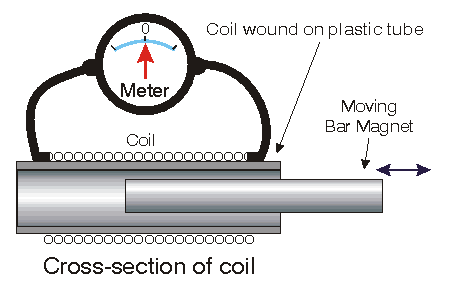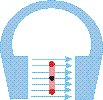
Alternating Current
Alternating Current and the generation of a sinewave
Introduction
The household electrical supply and the signal from a radio transmitter are
similar. Both are AC (alternating current) signals, but they differ in frequency. We
will first consider how a simple generator / dynamo / alternator works to
produce electricity and then
consider typical radio frequency signals. 
Consider a coil of fine insulated wire wound on a plastic or cardboard tube. Connect the ends of the coil to a DC milliammeter or galvanometer (for demonstration purposes!). A center-zero meter is preferred for this demonstration.
Now take a bar magnet and thrust the magnet into the coil. The meter will deflect.
Now withdraw the magnet. The meter deflects the other way.
As we insert and withdraw the magnet, the meter deflects from one side to the other.
With the magnet stationary, the meter reads zero.
What's happening?
We see that when the magnet is moving, a current is induced in the coil. The moving magnetic field, from the moving magnet, cuts the conductors forming the coil.
We can, by this simple experiment, deduce that the amplitude of the current depends on several things:
the strength of the magnet,
the rate of cutting of the conductors (i.e. the speed of movement of the magnet) and
the number of conductors (i.e. the number of turns on the coil).
We are converting mechanical energy (the movement of the magnet) into electrical energy. We have demonstrated Faraday's law of induction.
Other considerations To top of page
This conversion of mechanical energy (the movement of the magnet) into electrical energy, has other important aspects too.
The magnet could be stationary and the coil could move - we will consider this case again below.
This principle is the basis of generators, meters, loudspeakers, relays, and lots of other things too.
Consider the reverse operation too: A current could be fed to the coil. This would force the magnet to do the moving.
The magnet need not be a permanent magnet - it could be another coil, wound over the top. We could feed an AC signal to one coil, the rising and falling magnetic field from it sweeps across the other coil, generating an induced signal in the second coil (the secondary winding). The two coils are insulated from each other, the coupling is by the sweeping magnetic field. Nothing needs to make any physical movement. So we have a transformer.
Frequency
Placing the magnet into the coil and then removing back to the start point is one cycle. If we could take the magnet in and out of the coil every second, the polarity of the induced voltage would go through one cycle in one second. One cycle per second is one hertz (Hz). So when you see 'hertz' or 'Hz' just think of 'cycles per second'.
The alternating voltage provided to your house from the power grid repeats polarity 50 times a second and reaches 230 volts r.m.s. (the "rms" will be treated below). It is 230V 50 Hz.
The AC supply causes the electrons in the conductors in your house to first move one way and then the other. They are probably the same electrons that were there when the wiring was first installed. They just seesaw back and forth.
The device which creates your household power is called a generator. It works by creating relative motion between a conductor and a magnetic field.
The Generator To top of page
 Consider
a magnetic field that is constant in its intensity. In this field
is a rotating coil. For simplicity, this diagram on the left shows it as a single-turn loop.
The ends of the coil are brought out to a meter - the same
type of meter as before. In practice, slip-rings would be used to prevent
the wires tangling with rotation - but this complication has not been shown
here.
Consider
a magnetic field that is constant in its intensity. In this field
is a rotating coil. For simplicity, this diagram on the left shows it as a single-turn loop.
The ends of the coil are brought out to a meter - the same
type of meter as before. In practice, slip-rings would be used to prevent
the wires tangling with rotation - but this complication has not been shown
here. 
Please note that this meter has red and blue scale sections to show the change in polarity of the current as the coil rotates.
The coil is rotated in the constant magnetic field by mechanical means (in practice by water power or by diesel power etc.). Of course the design of a real generator is quite different - we are looking at the simple principles.
We are considering the current induced in each of the longer elements of the loop only - so please ignore any complications brought on by the end parts of the loop!
 When the plane
of the loop is vertical between the jaws of this magnet, the loop elements are moving
parallel with the direction of the magnetic field. The loop is not cutting any
lines of force. So the meter will read zero.
When the plane
of the loop is vertical between the jaws of this magnet, the loop elements are moving
parallel with the direction of the magnetic field. The loop is not cutting any
lines of force. So the meter will read zero.
When the plane of the loop is horizontal, the loop elements will be moving vertical in the jaws of this magnet, a maximum cutting of the magnetic field. So the meter will read maximum current.
As the loop rotates, the meter will read a current first in one direction, pass through zero, and then show a current in the other direction, then back to zero - one full cycle. It is shown here by the red and blue readings on the meter - a variation of our first example when we used a meter with a bar magnet.
Consider the angle made by the the plane of the loop with any vertical line on the diagram. This angle is significant. When the plane of the loop is vertical in the diagram, the plane of the loop is at zero degrees with a vertical line. When the plane of the loop is horizontal, this angle is 90 degrees.
The output current indicated on the meter follows this angle change - a sinewave.
 At
30 degrees, the current will be sin30 = 0.5 of the maximum, at 45 degrees, the current will be sin45 = 0.707 of the maximum, at 60 degrees,
0.866, and so on.
At
30 degrees, the current will be sin30 = 0.5 of the maximum, at 45 degrees, the current will be sin45 = 0.707 of the maximum, at 60 degrees,
0.866, and so on.
The frequency of the wave is related to the revolutions, one revolution produces one cycle. One cycle in one second is a 1 Hz signal.
The 50 Hz mains supply can be produced by mechanical means, and examples are in every powerhouse supplying the national grid. Fifty cycles in one second (50 Hz) is 3000 revolutions in each minute. Multi-polar machines are used in practice with a slower rotation speed.
It is difficult to produce radio frequencies by mechanical means so these are generated by electronic means. For example 7 MHz represents 7 million revolutions in one second. You can work out how many in one minute!
In practice, the hertz, Hz; the kilohertz, kHz; the megahertz, MHz; and the gigahertz, GHz; are used in radio work.
The time for one period
The time taken for one cycle, or one period, is the reciprocal of the frequency.
For example, a frequency of 50 cycles in one second, (i.e. 50 Hz), means that the time for one period is one-fiftieth of one second.
The time for one period of a 7 MHz signal is one-seven-millionth of one second, or one-seventh of one microsecond.
Harmonics
It is difficult to produce a pure sinewave. Signal impurities known as "harmonics" are exact multiples of the original fundamental signal. The harmonics can be odd-multiples or even-multiples of the fundamental signal, or both.
The presence of harmonics has the effect of altering the resulting wave-shape from being sinusoidal to being some other distorted waveform. The level of harmonic content can be very small and the wave-shape changes are often not detectable without the use of test equipment to determine the relative level of the harmonic frequency components.
Harmonics bring interference problems in radio operating too.
Voltage and other measurements To top of page
The measurement of an alternating voltage is not straightforward. If the "height to the crest of the wave" is measured, this is known as the "Peak Voltage". But it is not a measurement that is frequently-used, as these drawings show.

Diagram A shows a DC 230V supply. (Note: DC). It runs for one-hundredth of one second. If it had been feeding an electric heater, the heat produced would have been indicated by the area A.
Diagram B shows an AC 50 Hz supply in which the voltage peaks to 230V during one half-cycle of a sinewave. Again, the heating effect is related to the area under the curve. But in this case, less heat is produced. The loss of area under the curve when compared with the DC case can be seen. The AC supply reaches 230V for only an instant.
In Diagram C, the peak AC voltage has been deliberately increased to be higher than 230V so that the total area under the sinewave curve is the same area as in the DC case. Area C = Area A. The heating effect in C is the same effective heating as in case A. The difference is that the "waveform" is sinusoidal.
The 230V level in case C is known as the "RMS" value. This means "root-mean-square" and for amateur radio examination purposes, remember it as an area-under-the-curve adjustment to produce the same "heating effect" as an equivalent smooth DC value.
Diagram C is the waveform of the New Zealand mains supply: 230 volt AC 50 Hz, where the 230 is the rms value.
For a sinusoidal AC signal, the values you need to know are:
the peak value is 1.414 times the rms value, and,
the rms value is 0.707 times the peak value.
These relationships are quite easily proved mathematically and this information can be found in standard electrical textbooks. You just need to know the figures for the "equivalent heating effect" for a sinusoidal signal.
[ It should be noted that the 0.707 rms value is different to the "mean" or "average" value. Over one full cycle, the "average voltage" would be zero. But over one half-cycle, the average value for a sinewave is 0.637. The ratio of rms to mean values (0.707 to 0.637) is 1.11 for a sinewave. This is known as the "form factor" and is very dependent on the shape of a waveform. Don't confuse rms with mean or average value. ]
Question 1: For a 230V 50 Hz mains supply, what is the Peak Voltage?
Question 2: How many times in each cycle is this Peak Voltage reached?
____________________________________________